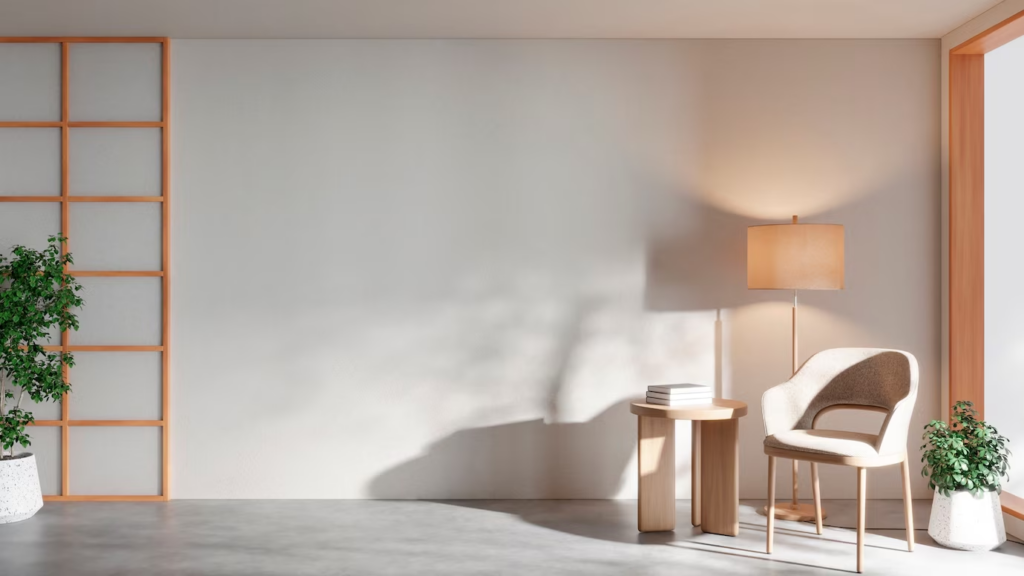Muji was initially a Japanese retail company renowned for its simplicity, functionality, and sustainability design philosophy. It’s derived from the first part of Mujirushi Ryōhin, a Japanese phrase that translates to “No-Brand Quality Goods.” This reflects the company’s commitment to producing high-quality products free from the unnecessary complexities often associated with branding.
Now, the term was eventually widely used in home designs. It represents a minimalist aesthetic characterized by neutral color palettes, clean lines, and function prioritization over form. It mainly focuses on minimalism, functionality, and the beauty of the ordinary. It aims to create tranquil, uncluttered, and harmonious spaces, reflecting a lifestyle that values simplicity and mindful living.
To learn more, here are key factors to follow to achieve Muji-inspired home decor:
Natural and Neutral Elements
Muji’s emphasis on natural and neutral elements reflects its dedication to simplicity and tranquility. Its color palette is often composed of earth tones, with shades of white, beige, gray, and brown. These colors not only evoke a sense of calm but are also versatile enough to fit seamlessly into any home aesthetic.
For materials, use natural materials like wood, cotton, and stone. Examples are a wicker bassinet for your baby or a solid oak or beech wood sofa with cotton or linen cushions in muted colors like beige or gray to complement the wood’s natural tones.
Natural materials are sustainable and durable and can add a warm, organic feel to the space. Their natural imperfections and variations in color and texture also contribute to the authentic, understated beauty characteristic of Muji’s minimalist philosophy.
Remember, the goal is to create a space that feels serene, simple, and connected to the natural world. The more you can incorporate natural and neutral elements into your decor, the closer you’ll get to achieving a Muji-style home.
Minimalism
Another way Muji-style homes create a simple and serene environment is through minimalism. It embraces the “less is more” mantra, focusing on the essentials and eliminating the unnecessary.
The minimalist approach emphasizes quality over quantity. It encourages having fewer but better-quality items that serve a functional purpose. This limits clutter and increases efficiency.
Here are some tips on how to implement Muji Minimalism:
- Start with decluttering – Before you introduce new elements, it’s essential to create a blank canvas. Clear your space of unnecessary items and keep only what’s meaningful and functional.
- Choose quality over quantity – Avoid impulse purchases and instead invest in, as mentioned, “fewer, high-quality items” that will stand the test of time. Each item in your space should serve a purpose and add aesthetic value.
- Mindful Consumption: Be thoughtful about what you bring into your home. This goes beyond furniture and decor. Muji minimalism encourages sustainability and conscious choices in all aspects of life, from the food you eat to the clothes you wear.
- Create “open” spaces – Avoid overfilling your rooms. Instead, emphasize the value of the space itself. Open floor plans and natural light contribute to a serene, spacious atmosphere.
Note that Miji promotes open space, which not only allows rooms to breathe but also helps us clear our minds. Choosing fewer high-quality items promotes mindful consumption as well. It reduces waste and promotes a more sustainable lifestyle.
Minimalist Aesthetics
Muji’s minimalism isn’t only for the things at home but also for the overall aesthetics of the house. Its aesthetic is deeply rooted in minimalistic design elements, such as clean lines and unfussy details.
Here are some examples of Muji’s minimalist aesthetics:
- Select lighting fixtures that diffuse light, like paper lanterns or frosted glass pendants.
- Opt for artwork that’s sparse and intentionally chosen.
- Go for limited and discreet artwork, preferably with natural themes that breathe life into the room without overwhelming it.
- Choose a few high-quality accessories that have a personal or sentimental value and allow them to stand alone in their beauty.

Functional Design
Muji’s design prioritizes the use of space and the multi-functionality of furniture without compromising its aesthetics. Specifically, every item should have a purpose and be thoughtfully chosen to serve that purpose.
Here are some tips for functional design in your Muji-style home:
- Minimize furniture pieces – As mentioned, each piece should have at least two functions or uses to maximize space.
- Use multipurpose decor – Incorporate items that serve a functional and aesthetic purpose, such as a wall-mounted coat rack that doubles as art.
- Utilize hidden storage – Invest in furniture with built-in storage options to keep clutter at bay.
- Keep surfaces clear – Avoid overcrowding tabletops and counters by keeping only essential items on display.
- Utilize vertical space – Use shelves and wall-mounted storage solutions to free up floor space.
- Consider flow – Arrange furniture to allow easy movement and access to different areas of the room.
Note that prioritizing functionality creates a clutter-free environment. It allows for fluidity and ease of movement within the space. It also promotes minimalism and reduces waste by encouraging intentional and mindful consumption.
Final Thoughts
In essence, choosing Muji as home design is about striving for a life of simplicity, functionality, and peace. It’s about creating a home that facilitates relaxation, clarity of mind, and mindful living. Remember, there’s no one-size-fits-all approach, so take your time, seek help when necessary, and enjoy the process.






